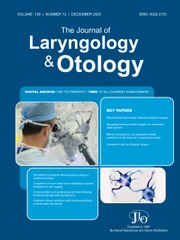No CrossRef data available.
Article contents
Optimal meatoplasty in canal wall down tympanomastoidectomy: a SMAART 2 flap technique
Published online by Cambridge University Press: 10 April 2025
Abstract
To identify ‘on-table optimal meatal opening size’ that predicts post-operative mastoid cavity healing in the canal wall down tympanomastoidectomy. To develop a specific, measurable, achievable, acceptable, replicable and time-bound (SMAART) meatoplasty.
A double-blind randomised control trial where patients were randomly assigned to standard Portmann 3 flap and new SMAART 2 flap technique.
There were 18 and 17 participants in the former and latter, respectively. Dry ear was achieved when the on-table ratio of tympanomastoid cavity volume to meatal opening size was 2:1. In a mastoid cavity of 6 ml or less, among the 2 flap patients, the majority had epithelialisation completed by the first month, meatoplasty having significantly shorter duration (12.2 versus 32.3 minutes) and cosmetically better than 3 flap.
Optimal meatoplasty is when tympanomastoid cavity volume ratio to meatal opening size is 2:1. When the on-table mastoid cavity is either 6 ml and less or is obliterated to 6 ml and less, the new SMAART 2 flap meatoplasty should be considered.
Information
- Type
- Main Article
- Information
- Copyright
- © The Author(s), 2025. Published by Cambridge University Press on behalf of J.L.O. (1984) LIMITED.
Footnotes
I would like to mention that this study was a part of my post-graduation thesis and has been presented at the International Federation of Otorhinolaryngological Societies (IFOS) Dubai in January 2023.

